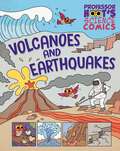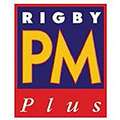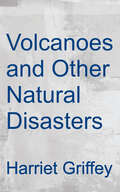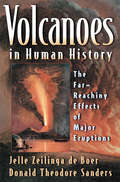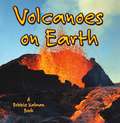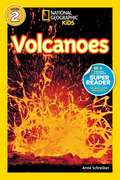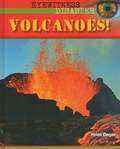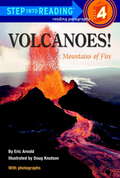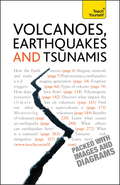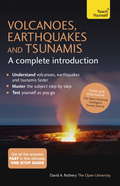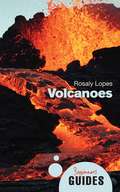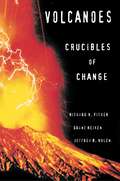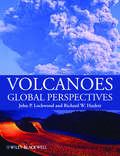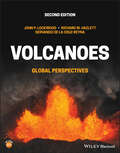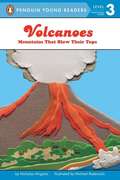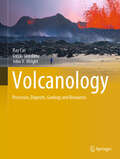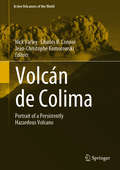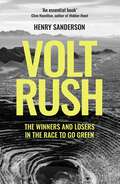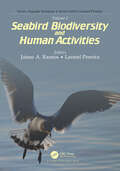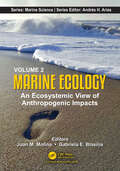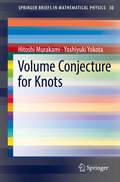- Table View
- List View
Volcanoes and Earthquakes (Professor Hoot's Science Comics #4)
by Jen GreenEvery day brings a new adventure for Professor Hoot - and a new learning experience. There's a plume of smoke in the distance, it looks like a volcano has erupted! Professor Hoot sets off to investigate all about volcanoes and how they are formed, all while avoiding smoky feathers! Discover other natural distasters, such as earthquakes, tsunamis and landslides - and what to do in such events.An entertaining comic strip approach to KS1 science topics, Professor Hoot's Science Comics are accessible and full of fun. Each book is an adventure and a chance for readers to learn something new, before testing their knowledge at the end of each book in Professor Hoot's quiz. Collect each adventure: Big Machines; Dangerous Animals; Dinosaurs; Robots and AI; Space; Volcanoes and Earthquakes.
Volcanoes and Geysers (Rigby PM Plus Non Fiction Ruby (Levels 27-28), Fountas & Pinnell Select Collections Grade 3 Level Q)
by Mary DraperThis text introduces children to volcanoes and volcanic activity. It also describes the effect of volcanic activity upon the environment. Other text forms include diagrams, explanations and a newspaper report.
Volcanoes and Other Natural Disasters (Dk Readers Series Dorling Kindersley Readers)
by Dorling Kindersley Publishing Staff Harriet GriffeyDescribes natural disasters which have occurred in various places throughout the world including the eruption of Vesuvius in 79 A.D., the Yellow River flood in 1887, and the Australian bush fires in 1983.
Volcanoes in Human History
by Jelle Zeilinga de Boer Donald Theodore Sanders Robert D. BallardWhen the volcano Tambora erupted in Indonesia in 1815, as many as 100,000 people perished as a result of the blast and an ensuing famine caused by the destruction of rice fields on Sumbawa and neighboring islands. Gases and dust particles ejected into the atmosphere changed weather patterns around the world, resulting in the infamous ''year without a summer'' in North America, food riots in Europe, and a widespread cholera epidemic. And the gloomy weather inspired Mary Shelley to write the gothic novel Frankenstein.This book tells the story of nine such epic volcanic events, explaining the related geology for the general reader and exploring the myriad ways in which the earth's volcanism has affected human history. Zeilinga de Boer and Sanders describe in depth how volcanic activity has had long-lasting effects on societies, cultures, and the environment. After introducing the origins and mechanisms of volcanism, the authors draw on ancient as well as modern accounts--from folklore to poetry and from philosophy to literature. Beginning with the Bronze Age eruption that caused the demise of Minoan Crete, the book tells the human and geological stories of eruptions of such volcanoes as Vesuvius, Krakatau, Mount Pelée, and Tristan da Cunha. Along the way, it shows how volcanism shaped religion in Hawaii, permeated Icelandic mythology and literature, caused widespread population migrations, and spurred scientific discovery.From the prodigious eruption of Thera more than 3,600 years ago to the relative burp of Mount St. Helens in 1980, the results of volcanism attest to the enduring connections between geology and human destiny.
Volcanoes of the Azores (Active Volcanoes of the World)
by Ulrich Kueppers Christoph BeierThe Azores archipelago consists of nine islands that emerge from the Azores Plateau in the Central Northern Atlantic, situated within the triple junction of the American, Eurasian and African lithosphere plates. Subaerial volcanic activity has been well known since the Pliocene and continues today, with several well-documented eruptions since the settlement of the islands in the fifteenth century. The origin of the Azores Plateau has been a matter of scientific debate and thus this book provides the first comprehensive overview of geological features in the Azores from volcanological, geochemical, petrological, paleontological, structural and hydrological perspectives
Volcanoes on Earth
by Bobbie KalmanDramatic photographs of spewing and flowing lava will capture the attention of any child. in this fantastic new book, children will be excited to learn what a volcano is and what makes it erupt. Simple explanations describe the different kinds of volcanoes, including cinder, cone-shaped, shield, and composite as well as the different kinds of lava and the land formations they create on land and under the ocean. Other topics include the reason volcanoes often erupt during earthquakes, why giant tsunami waves are sometimes created by underwater earthquakes, and how volcanoes are studied in order to predict and prepare for eruptions. Children will also enjoy making their own volcano out of household materials.
Volcanoes!
by Anne SchreiberThe cool story of volcanoes will intrigue kids and adults alike. Hot melted rock from the middle of our planet forces its way up through cracks in the Earth’s crusts, exploding violently and sometimes unexpectedly in volcanic fury that can terrorize populations for months, even years. Anne Schreiber’s narrative gives readers a little of the science, a little of the history, and a lot of the action.
Volcanoes!
by Helen DwyerProduces the facts on volcanoes, like what is a volcano, where they are found, and basic information on the same
Volcanoes!: Mountains of Fire (Step into Reading)
by Eric ArnoldA volcano could be called a sleeping mountain--that is, until it wakes up! What is it like to witness the eruption of one of nature's majestic time bombs? Young readers can learn what makes volcanoes "tick," and read about some of the most famous eruptions in history.
Volcanoes, Earthquakes And Tsunamis: Teach Yourself
by David RotheryVolcanoes, Earthquakes and Tsunamis is the essential guide to what causes the most frightening geological events with which we are faced today. It covers plate tectonics, the intricacies of each terrible phenomina, and their effects as well as the impact they have on each other, how they can be predicted and, if possible, controlled.NOT GOT MUCH TIME?One, five and ten-minute introductions to key principles to get you started.AUTHOR INSIGHTSLots of instant help with common problems and quick tips for success, based on the author's many years of experience.EXTEND YOUR KNOWLEDGEExtra online articles at www.teachyourself.com to give you a richer understanding.THINGS TO REMEMBERQuick refreshers to help you remember the key facts.
Volcanoes, Earthquakes and Tsunamis: A Complete Introduction: Teach Yourself
by David RotheryHow do volcanoes erupt, what makes earthquakes so destructive, and why do tsunamis happen?Volcanoes, Earthquakes and Tsunamis answers these questions and more, giving you everything you need to know about these powerful natural phenomena. It covers the plate tectonic background to Earth processes, where magma is made and how it erupts, volcano types, eruption hazards and how they are monitored, faults and earthquakes, the causes of tsunamis and tsunami preparedness. You will examine many examples of these frightening events, find out to what extent they can be predicted and mitigated against, and come to realize how they are related and the impact they have on human society and the natural world.Written by Dr David Rothery, a volcanologist, geologist, planetary scientist and Professor of Planetary Geosciences at the Open University, Volcanoes, Earthquakes and Tsunamis: A Complete Introduction is designed to give you everything you need to know, all in one place. It covers the key areas that students are expected to be confident in, outlining the basics in clear English and providing added-value features like a glossary of essential terms and even examples of questions you might be asked in your seminar or exam.The book covers the essentials of most university courses, with an introduction on how the Earth moves, followed by separate sections on volcanoes (including eruptions, types of volcano, volcanic hazards, volcanoes and climate, monitoring volcanoes, predicting eruptions and living with volcanoes), earthquakes (including faults, measurement, seismic monitoring, prediction, prevention and preparedness) and tsunamis.The colour plates referred to in the book can be downloaded from the Teach Yourself online library or accessed through the Teach Yourself Library app.
Volcanoes, Earthquakes and Tsunamis: Teach Yourself
by David RotheryWritten by Dr David Rothery, a volcanologist, geologist, planetary scientist and Professor of Planetary Geosciences at the Open University, Volcanoes, Earthquakes and Tsunamis: A Complete Introduction is designed to give you everything you need to succeed, all in one place. It covers the key areas that students are expected to be confident in, outlining the basics in clear English and providing added-value features like a glossary of essential terms and even examples of questions you might be asked in your seminar or exam.The book uses a structure chosen to cover the essentials of most university courses, with an introduction on how the Earth moves, followed by separate sections on volcanoes (including eruptions, types of volcano, volcanic hazards, volcanoes and climate, monitoring volcanoes, predicting eruptions and living with volcanoes), earthquakes (including faults, measurement, seismic monitoring, prediction, prevention and preparedness) and tsunamis.
Volcanoes: A Beginner's Guide (Beginner's Guides)
by Rosaly LopesWhether worshiped, feared, or studied, volcanoes have always been a subject of fascination and awe. Lopes explains the importance of volcanoes in shaping worlds, the dangers of volcanic eruptions, and some of the best places in the world to see eruptions, as well as including famous "case histories". Dr Rosaly Lopes is a Principal Scientist at NASA's Jet Propulsion Laboratory, where she is also Lead Scientist for Geophysics and Planetary Geosciences. She was honoured in the 2006 edition of the Guinness Book of World Records as the discoverer of the most active volcanoes anywhere.
Volcanoes: Crucibles of Change
by Grant Heiken Richard V. Fisher Jeffrey HulenWhenever a volcano threatens to erupt, scientists and adventurers from around the world flock to the site in response to the irresistible allure of one of nature's most dangerous and unpredictable phenomena. In a unique book probing the science and mystery of these fiery features, the authors chronicle not only their geologic behavior but also their profound effect on human life. From Mount Vesuvius to Mount St. Helens, the book covers the surprisingly large variety of volcanoes, the subtle to conspicuous signs preceding their eruptions, and their far-reaching atmospheric consequences. Here scientific facts take on a very human dimension, as the authors draw upon actual encounters with volcanoes, often through firsthand accounts of those who have witnessed eruptions and miraculously survived the aftermath. The book begins with a description of the lethal May 1980 eruption of Mount St. Helens--complete with an explanation of how safety officials and scientists tried to predict events, and how unsuspecting campers and loggers miles away struggled against terrifying blasts of ash, stone, and heat. The story moves quickly to the ways volcanoes have enhanced our lives, creating mineral-rich land, clean thermal energy, and haunting landscapes that in turn benefit agriculture, recreation, mining, and commerce. Religion and psychology embroider the account, as the authors explore the impact of volcanoes on the human psyche through tales of the capricious volcano gods and attempts to appease them, ranging from simple homage to horrific ritual sacrifice. Volcanoes concludes by assisting readers in experiencing these geological phenomena for themselves. An unprecedented "tourist guide to volcanoes" outlines over forty sites throughout the world. Not only will travelers find information on where to go and how to get there, they will also learn what precautions to take at each volcano. Tourists, amateur naturalists, and armchair travelers alike will find their scientific curiosity whetted by this informative and entertaining book.
Volcanoes: Global Perspectives
by Richard W. Hazlett John P. LockwoodVolcanoes are essential elements in the delicate global balance of elemental forces that govern both the dynamic evolution of the Earth and the nature of Life itself. Without volcanic activity, life as we know it would not exist on our planet. Although beautiful to behold, volcanoes are also potentially destructive, and understanding their nature is critical to prevent major loss of life in the future. Richly illustrated with over 300 original color photographs and diagrams the book is written in an informal manner, with minimum use of jargon, and relies heavily on first-person, eye-witness accounts of eruptive activity at both "red" (effusive) and "grey" (explosive) volcanoes to illustrate the full spectrum of volcanic processes and their products. Decades of teaching in university classrooms and fieldwork on active volcanoes throughout the world have provided the authors with unique experiences that they have distilled into a highly readable textbook of lasting value. Questions for Thought, Study, and Discussion, Suggestions for Further Reading, and a comprehensive list of source references make this work a major resource for further study of volcanology. Volcanoes maintains three core foci: Global perspectives explain volcanoes in terms of their tectonic positions on Earth and their roles in earth history Environmental perspectives describe the essential role of volcanism in the moderation of terrestrial climate and atmosphere Humanitarian perspectives discuss the major influences of volcanoes on human societies. This latter is especially important as resource scarcities and environmental issues loom over our world, and as increasing numbers of people are threatened by volcanic hazards Readership Volcanologists, advanced undergraduate, and graduate students in earth science and related degree courses, and volcano enthusiasts worldwide. A companion website is also available for this title at www.wiley.com/go/lockwood/volcanoes
Volcanoes: Global Perspectives
by Richard W. Hazlett John P. Lockwood Servando de la Cruz-ReynaVOLCANOES Since the publication of the first edition of Volcanoes in 2010, our world of volcanology has changed in exciting ways. Volcanoes have continued to erupt (some 61 eruptions with VEI magnitudes greater than 3 have taken place since 2010), and in this revised and updated edition, the authors describe the largest of these, and the ones that have had the most impact on society. Volcanoes, Second Edition, contains more than 80 new photographs and figures to better illustrate volcanic features and processes, with an updated Bibliography that includes important papers describing recent eruptions and new findings. Volcanologic research is improving the foundations of knowledge upon which all our science rests, and we briefly summarize the most important of these advances and new research tools developed over the past eleven years. The most productive of these new tools are remotely operated, constantly monitoring volcanoes and their impacts on the Earth’s atmosphere from space and exploring new volcanic worlds beyond the bounds of Earth. Remotely Operated Vehicles (ROVs) are now widely available to understand better the most active volcanoes on Earth - those beneath the sea. This superlative textbook will enable students who may never see an erupting volcano to evaluate news stories about far-away eruptions, and to distinguish between overly sensational stories and factual reporting that puts facts in context. Emergency managers, land use planners, and civic officials also need to understand volcanic processes when their communities are threatened – this book will inform and guide them in their decision-making. Avoiding overly technical discussions and unnecessary use of jargon, with the important needs of civil authorities, teachers and students particularly in mind, this second edition of Volcanoes will also be of interest to general readers who are interested in these fascinating and ever-changing features of our dynamic planet.
Volcanoes: Let's-Read-and-Find-Out Science
by Franklyn M. BranleyThis is a Stage 1 Let's-Read-and-Find-Out, which means the book explains simple science concepts for preschoolers and kindergarteners.
Volcanoes: Mountains That Blow Their Tops (All aboard reading #Level 2, grades 1-3)
by Nicholas NirgiotisThe book describes the formation and activities of volcanoes and identifies some notable eruptions.
Volcanology: Processes, Deposits, Geology and Resources (Springer Textbooks in Earth Sciences, Geography and Environment)
by Ray Cas Guido Giordano John V. WrightThis book is a substantially updated, revised and extended version of the book Volcanic Successions, published by Cas and Wright back in 1987. Divided into six major parts, it offers comprehensive information on magma properties; fragmentation processes; subaerial and subaqueous lava types and field textures; sub-volcanic intrusions; explosive or pyroclastic eruptions and deposits; surface sedimentary processes; hydrothermal alteration and lithification, and effects on volcanic rock textures; terminology and approaches to describing and mapping volcanic rocks and terrains; geology of volcanoes and facies models; volcanism and tectonic setting; and to conclude, volcanic-hosted resources. It is a highly up-to-date text, presenting a coherent flow of topics, together with excellent visual material to illustrate key points and deposit features. The new authorship team consists of Ray Cas, Guido Giordano and John Wright, all of whom have extensive experience across the complete spectrum of volcanological processes and deposit types discussed in this exciting new book. The authors approach the diversity of products in volcanic terrains as facies, and use facies analysis and interpretation as a means of constructing facies models for different volcanic settings and their resources. The book is intended as a textbook and research reference book for senior undergraduate and graduate students, researchers and professionals alike.
Volcán de Colima: Portrait of a Persistently Hazardous Volcano (Active Volcanoes of the World)
by Nick Varley Charles B. Connor Jean-Christophe KomorowskiThis book represents a comprehensive coverage of the current state of knowledge of Volcán de Colima: its history, its eruptive mechanism, the generation and interpretation of monitoring data, and the risk presented to the local population. The volume pulls together the results of the most important studies of recent years from many areas of volcanology: the geology of its eruptive products; geophysical and geochemical studies of the signals measured that relate to the generation and movement of magma; experimental analysis of its internal processes and the social complexities relating to the risk imposed by future eruptions. Volcán de Colima is an important volcano: it has frequent large Plinian or sub-Plinian eruptions; its activity frequently switches between various regimes, which provides the opportunity to study these transitions from their cause to their impact; and it is a volcano which poses a significant threat to a large population.
Volt Rush: The Winners and Losers in the Race to Go Green
by Henry Sanderson'A remarkably hopeful and useful book...The climate crisis leaves us no choice but to build a new world and as Sanderson makes clear, we are capable of making it a better one than the dirty and dangerous planet we&’ve come to take for granted.' Bill McKibben, Observer book of the week We depend on a handful of metals and rare earths to power our phones and computers. Increasingly, we rely on them to power our cars and our homes. Whoever controls these finite commodities will become rich beyond imagining. Sanderson journeys to meet the characters, companies, and nations scrambling for the new resources, linking remote mines in the Congo and Chile&’s Atacama Desert to giant Chinese battery factories, shadowy commodity traders, secretive billionaires, a new generation of scientists attempting to solve the dilemma of a &‘greener&’ world.
Volume 1: Seabird Biodiversity and Human Activities (Aquatic Sciences)
by Jaime A. RamosSeabirds are global travellers connecting oceans and seas all over the world, and facing multiple threats at local and global scales. Seabirds are long-lived top predators, reflecting changes at lower trophic levels, and are good models to assess ecological changes produced by human societies. Thus, world-wide collaborations are needed to understand seabird ecology and to develop effective conservation measures benefitting both humans and seabird populations.This book provides a modern overview on seabird biodiversity studies: it begins by covering the most up-to-date techniques to study seabirds, and then focus on pragmatic issues related with interactions between seabirds and humans, the use of seabirds as ecological indicators and conservation of seabirds. It gives an updated insight on all these topics and highlights gaps that need further development for a comprehensive understanding of the relationships between seabirds and human actions.This book covers the response of the seabird research community to a biodiversity crisis aiming to contribute towards environmental sustainability. It should provide inspiration to a wide range of professionals and students, including the much needed world-wide collaboration between research groups and practitioners. In this way seabird research and conservation provide an inspiration for the solution of global issues such as climate change.
Volume 2: An Ecosystemic View of Anthropogenic Impacts (Marine Science Series)
by Juan M. Molina Gabriela E. BlasinaMarine systems face a multitude of anthropogenic stressors such as climate change, recreational and commercial fishing, aquaculture practices, pollution, and coastal urbanization. These stressors exert escalating pressure on marine ecosystems, leading to noticeable changes in habitat conditions as well as alterations in the abundance and diversity of their communities. Understanding the impacts of these stressors proves challenging due to their interactions with various factors, such as species richness, environmental fluctuations, system openness, stressor tolerance, and the occurrence rate and intensity of each stressor. Therefore, a comprehensive analysis of the entire ecosystem is crucial. It is essential to consider the unique characteristics of each marine environment when assessing the cumulative stress that affects them. This book provides insights into the functioning of marine ecosystems and their responses to both natural and human-induced drivers within the framework of sustainable marine resource utilization. This book will make a valuable contribution to the scientific community, serving as a resource to inform decision-makers and the general public about the current state of knowledge regarding the marine environment and the human footprints on our seas.
Volume 5: Maritime Communities and Vegetation of Open Habitats
by J. S. RodwellBritish Plant Communities is the first systematic and comprehensive account of the vegetation types of this country. It covers all natural, semi-natural and major artificial habitats in Great Britain (but not Northern Ireland), representing the fruits of fifteen years of research by leading plant ecologists. The book breaks new ground in wedding the rigorous interest in the classification of plant communities that has characterized Continental phytosociology with the deep concern traditional in Great Britain to understand how vegetation works. The published volumes have been greeted with universal acclaim, and the series has become firmly established as a framework for a wide variety of teaching, research and management activities in ecology, conservation and land-use planning.
Volume Conjecture for Knots (SpringerBriefs in Mathematical Physics #30)
by Hitoshi Murakami Yoshiyuki YokotaThe volume conjecture states that a certain limit of the colored Jones polynomial of a knot in the three-dimensional sphere would give the volume of the knot complement. Here the colored Jones polynomial is a generalization of the celebrated Jones polynomial and is defined by using a so-called R-matrix that is associated with the N-dimensional representation of the Lie algebra sl(2;C). The volume conjecture was first stated by R. Kashaev in terms of his own invariant defined by using the quantum dilogarithm. Later H. Murakami and J. Murakami proved that Kashaev’s invariant is nothing but the N-dimensional colored Jones polynomial evaluated at the Nth root of unity. Then the volume conjecture turns out to be a conjecture that relates an algebraic object, the colored Jones polynomial, with a geometric object, the volume.In this book we start with the definition of the colored Jones polynomial by using braid presentations of knots. Then we state the volume conjecture and give a very elementary proof of the conjecture for the figure-eight knot following T. Ekholm. We then give a rough idea of the “proof”, that is, we show why we think the conjecture is true at least in the case of hyperbolic knots by showing how the summation formula for the colored Jones polynomial “looks like” the hyperbolicity equations of the knot complement.We also describe a generalization of the volume conjecture that corresponds to a deformation of the complete hyperbolic structure of a knot complement. This generalization would relate the colored Jones polynomial of a knot to the volume and the Chern–Simons invariant of a certain representation of the fundamental group of the knot complement to the Lie group SL(2;C).We finish by mentioning further generalizations of the volume conjecture.
